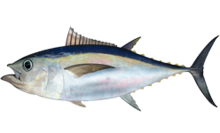Bigeye tuna
| Bigeye tuna | |
|---|---|
 |
|
| Scientific classification | |
| Kingdom: | Animalia |
| Phylum: | Chordata |
| Class: | Actinopterygii |
| Order: | Perciformes |
| Family: | Scombridae |
| Genus: | Thunnus |
| Subgenus: | Thunnus |
| Species: | T. obesus |
| Binomial name | |
|
Thunnus obesus (Lowe, 1839) |
|
| Synonyms | |
|
|
Bigeye tuna, Thunnus obesus, is an important food fish and prized recreational game fish. It is a true tuna of the genus Thunnus, belonging to the wider mackerel family Scombridae.
In Hawaiian, it is one of two species known as ʻahi; the other is yellowfin tuna.
Bigeye tuna are found in the open waters of all tropical and temperate oceans, but not the Mediterranean Sea.
Bigeye tuna can grow up to 250 centimetres (98 in) in length. Maximum weight of individuals probably exceeds 180 kg (400 lb), with the all-tackle angling record standing at 178 kg (392 lb). They are large, deep-bodied, streamlined fish with large heads and eyes. The pectoral fins are very long, reaching back beyond the start of the second dorsal fin in juveniles and the space between the first and second dorsal fin in adults. They have 13 or 14 dorsal spines.
Bigeye tuna have a unique physiology which allows them to forage in deeper colder waters and tolerate oxygen-poor waters. Bigeye tuna are reported to tolerate ambient oxygen levels of 1.0 ml/L and routinely reach depths where ambient oxygen content is below 1.5 ml/L, largely due to the presence of blood with a high oxygen affinity. Vascular counter-current heat exchangers maintain body temperatures above ambient water temperature. These heat exchangers are engaged to conserve heat in deeper colder waters and are disengaged to allow rapid warming as the tuna ascend from cold water into warmer surface waters, providing short-latency, physiological thermoregulation. The eyes of bigeye tuna are well developed and with a large spherical lens allowing their vision to function well in low light conditions.
Conventional tagging data and counts of growth increments in otoliths (ear bones) of bigeye tuna have recorded a maximum age of 16 years. Recorded lengths at which sexual maturity is attained varies geographically with a length at which 50% of fishes sampled are mature of 135 cm in the eastern Pacific Ocean and 102–105 cm in the western Pacific Ocean. This translates to an age of maturity of 2 – 4 years. Differences in methods of studies may contribute to this variability. Spawning takes place across most months of the year in tropical regions of the Pacific Ocean, becoming seasonal at higher latitudes when sea surface temperatures are above 24 °C. In the northwestern tropical Atlantic spawning occurs in June and July, and in January and February in the Gulf of Guinea, which is the only known Atlantic nursery area.
...
Wikipedia

